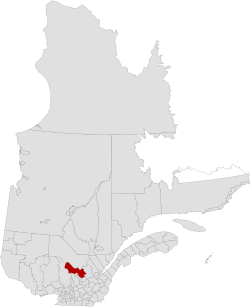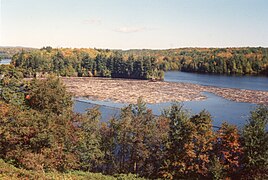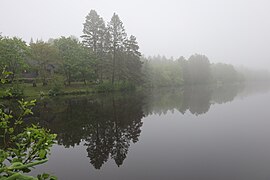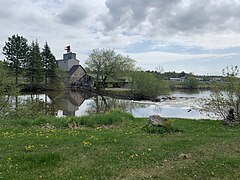|
Mékinac Regional County Municipality
Established in January 1982, the Mékinac RCM is made up of 10 or 11 municipalities depending on the source, Saint-Tite is the most populous city, four unorganized territories occupying two-thirds of its surface area.[3][4] GeographyEleven municipalities and Unorganized Territories make up the RCM de Mékinac. It is distinguished by a huge forest dotted with more than 2,000 lakes, agriculture adapted to the environment, popular holiday sites and picturesque villages. The Mékinac RCM is located on both sides of the Saint-Maurice River, between the upper and central Mauricie regions. It is adjacent to the RCMs of Matawinie, Maskinongé, Centre-du-Québec, Les Chenaux, Portneuf and Haut-Saint-Maurice. As part of the Mauricie administrative region, it is divided into two provincial electoral districts; Portneuf and Laviolette, while the federal riding is Champlain.[4] Concentrated in the southeastern tip of the territory, agricultural land corresponds to the limit of the invasion of the Champlain Sea. There is also some land cleared for cultivation in certain settlement hamlets scattered between the Laurentian Mountains, on the banks of the Mékinac River, and the northern portion of the Batiscan River. The forest covers nearly 93% of the total area of the Mékinac RCM. It was the raison d'être of the colonization of the territory and still supports 20% of all jobs. Forest ownership is shared between: the provincial government (public lands), the federal government (La Mauricie National Park) and approximately 587 private landowners, with a proportion of 79%, 1% and 20% of the forest respectively.[4] Hydrology: 3 major rivers - 4,665 lakesThe Saint-Maurice River, the Batiscan River and the Sainte-Anne River flow from west to east on the territory of the MRC de Mékinac, the hydrographic network includes:
The Mékinac RCM has 4,665 lakes for a total area of 34,272.8 ha (342.7 km2).
PhotosThe Mauricie region river's Saint-Maurice, Batiscan, Sainte-Anne (Les Chenaux) and their tributaries cross the territory of Mékinac RCM
Toponymy
The Algonquin Mikinak means turtle. Native Americans often referred to places based on the naming of the animal kingdom. Once well known, the toponym made it possible to refer to the same place in conversations. The designation Mikinak would have been assigned to a nearby mountain. However, it remains possible that the abundance of turtles in this portion of the territory explains this name[8] However, the name is also similar to the historical Algonquin word mekanâc, pronounced /me:kana:ʃ/, meaning "small path". The toponym Mekinac was assigned to the Mékinac River, Mékinac Lake, at Mékinac (township), in the ex-municipality of Saint-Joseph-de-Mékinac, Quebec, and town of Saint-Roch-de-Mékinac. The foothills of the Laurentians are located in Saint-Tite. The Laurentide hinterland is developed for hunting and fishing; it includes, among others, the Tawachiche, Gros-Brochet and Chapeau-de-Paille zecs, as well as the Saint-Maurice Wildlife Reserve[3]
Municipalities of RCM MékinacThe RCM has 14 entities
Between 2006 and 2011, the population grew by 2.0%. The RCM has 8,237 private dwellings whose 6,096 private dwellings are occupied by usual residents. The median age of the population is 52.6 years old. Statistics Canada reports that in 2011, 88.5% of the population was aged 15 and over, meanings 11,430 individuals (including 5700 men and 5730 women), divided into 3,940 private households. This census indicates that 2,070 people lived alone. Of this population, 1,880 individuals have mastered both French and English, or 14.6%.[10] TransportationAccess routesHighways and numbered routes that run through the municipality, including external routes that start or finish at the county border:[11]
See also
References
|
||||||||||||||||||||||||||||||||||||||||||||||||||||||||||||||||||||||||||||||||||||||||||||||||||||||||||||||||||||||||||||||||||||||||








![Rivière des Envies, from bridge P-03960, steel-wood (1918),[6] rang du Haut-du-Lac Nord, Saint-Tite](http://upload.wikimedia.org/wikipedia/commons/thumb/e/e1/Saint_Tite_089.jpg/240px-Saint_Tite_089.jpg)




